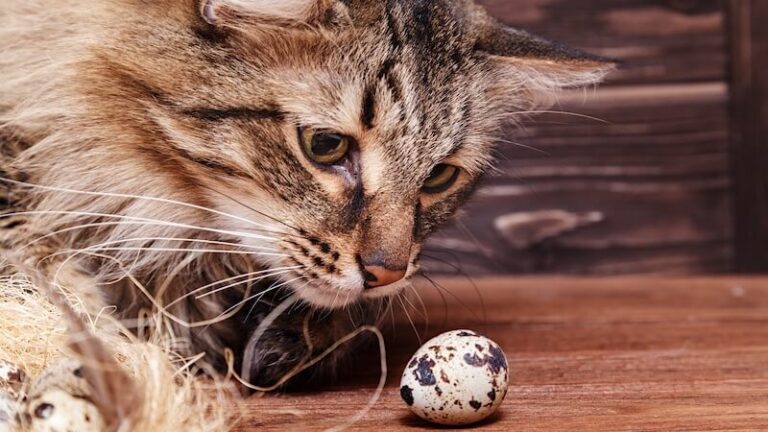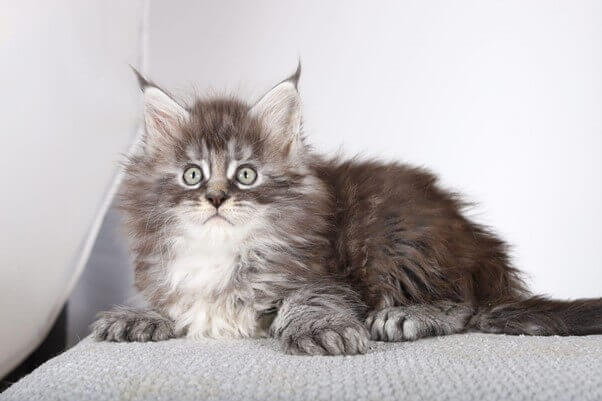Hairless Cat Breeds: A Complete Guide to the Top 10 Unique Breeds and Their Care Needs
Hairless cats are captivating creatures that stand out with their unique appearance and distinct personalities. Although some assume these cats require minimal grooming, their lack of fur actually demands specialized care.
Hairless breeds are more sensitive to environmental factors like sun, heat, and cold, making attentive grooming and skincare crucial to their well-being. Below, we’ll explore the top 10 hairless cat breeds, delve into their special characteristics, and provide a comprehensive care guide to help owners maintain their health and comfort.
Top 10 Hairless Cat Breeds
1. Sphynx Cat
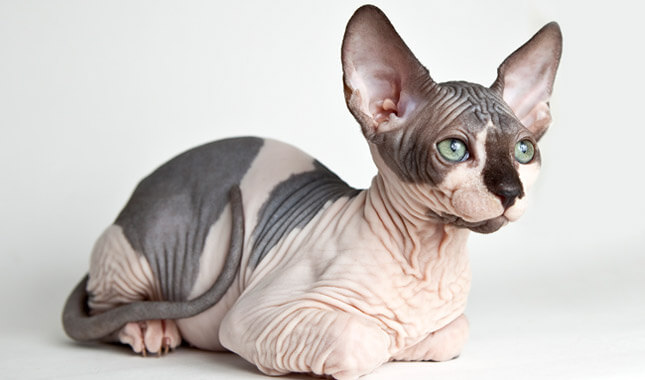
The Sphynx is perhaps the most famous hairless breed, known for its smooth, wrinkled skin and large, bat-like ears. These cats are highly social, energetic, and affectionate, often described as dog-like in their loyalty to their owners.
- Physical Traits: Wrinkled skin, large eyes, and ears; muscular body.
- Personality: Playful, friendly, curious, and attention-seeking.
- Care Needs: Regular bathing is essential due to their oily skin. Sphynx cats are prone to acne and need gentle skin care to prevent irritations.
- Price Range: $1,500 – $3,000.
2. Donskoy Cat
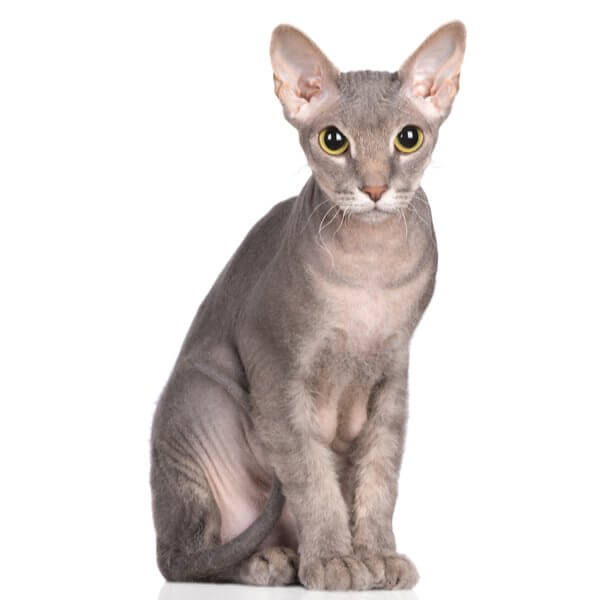
The Donskoy originates from Russia and is known for its soft, elastic skin and variable hairlessness. Some Donskoys are born with a light fuzz that they may lose over time.
- Physical Traits: Wrinkled, elastic skin; almond-shaped eyes; strong, muscular build.
- Personality: Friendly, intelligent, and playful; forms strong bonds with family members.
- Care Needs: Frequent baths and moisturizing to prevent dryness. Donskoys also need sun protection and temperature control.
- Price Range: $1,200 – $3,000.
3. Peterbald Cat
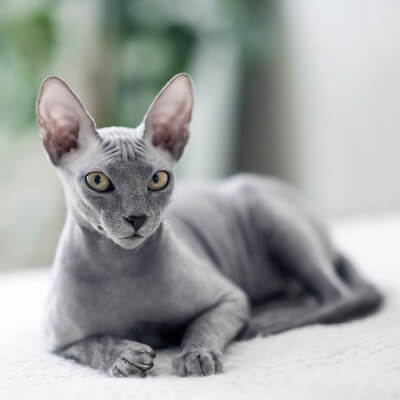
The Peterbald, another Russian breed, is a slender, graceful cat with a wide range of hairless to lightly furred coats. Peterbalds can be completely hairless or have a velvety coat.
- Physical Traits: Long limbs, narrow head, and large, expressive eyes.
- Personality: Affectionate, social, and good with children and other pets.
- Care Needs: Peterbalds need regular baths to keep their skin oil-free, and their thin skin makes them prone to scratches, so gentle handling is advised.
- Price Range: $1,700 – $3,500.
4. Bambino Cat
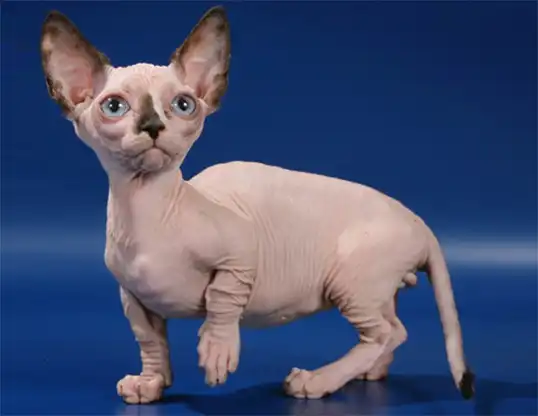
The Bambino is a cross between the Sphynx and the Munchkin breed, giving it the signature short legs of the Munchkin. Their small size and distinctive appearance make them highly appealing.
- Physical Traits: Short legs, large ears, and hairless body.
- Personality: Lively, affectionate, and playful.
- Care Needs: Due to their delicate skin, Bambinos need regular baths, protection from the elements, and moisturizing.
- Price Range: $1,800 – $3,000.
Related: Most Expensive Cat Breeds
5. Elf Cat
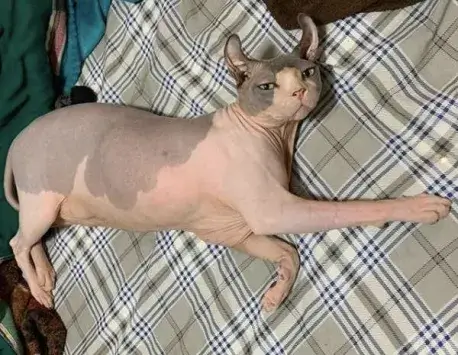
The Elf cat combines the hairlessness of the Sphynx with curled ears, giving it a distinctive look. This breed is relatively new, yet quickly growing in popularity.
- Physical Traits: Curled ears, muscular build, hairless skin.
- Personality: Friendly, playful, and highly social.
- Care Needs: Frequent cleaning and bathing to maintain skin health. Elf cats are prone to ear infections, so regular ear cleaning is essential.
- Price Range: $2,000 – $3,500.
6. Ukrainian Levkoy Cat
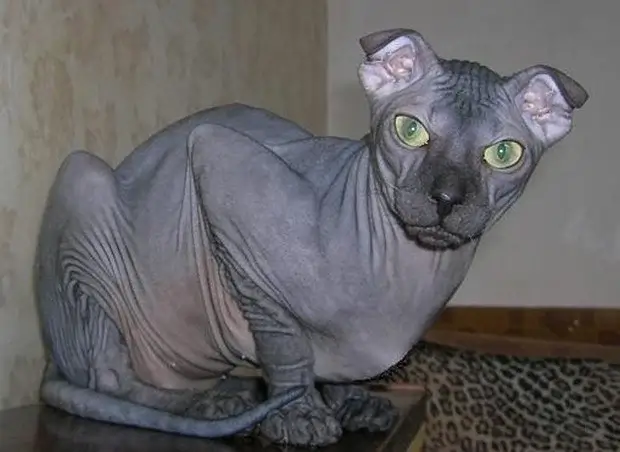
The Ukrainian Levkoy is known for its folded ears and unique, slightly angular head shape. It’s a relatively rare breed, primarily found in Eastern Europe.
- Physical Traits: Folded ears, angular face, lean body.
- Personality: Gentle, affectionate, and social with family.
- Care Needs: These cats need frequent bathing and moisturizing. Due to their folded ears, ear cleaning is also crucial to prevent infections.
- Price Range: $1,500 – $2,500.
7. Lykoi Cat
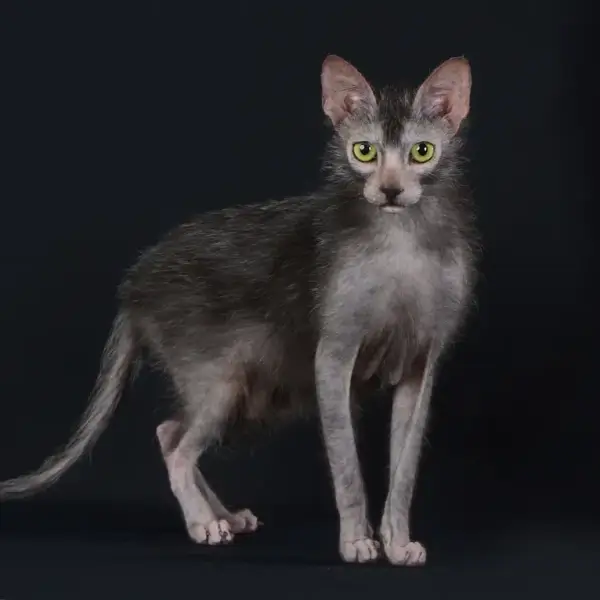
Although not completely hairless, the Lykoi, also called the “Werewolf Cat,” has a patchy coat that gives it a wild appearance. Known for their unique “wolfing out” phase, these cats are part of the hairless family due to their partial hairlessness.
- Physical Traits: Sparse fur with a “werewolf” appearance, medium build.
- Personality: Intelligent, independent, and curious.
- Care Needs: Occasional bathing and skincare to manage oil buildup. Protect them from extreme temperatures.
- Price Range: $1,500 – $2,500.
8. Dwelf Cat
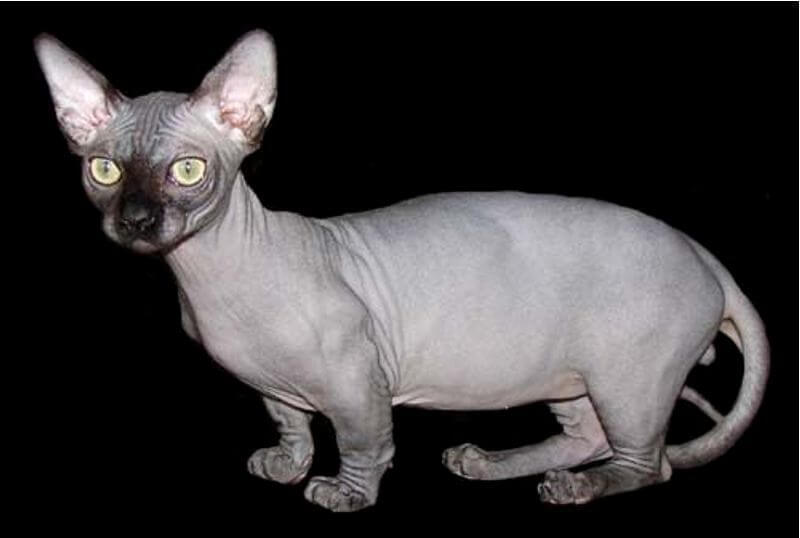
The Dwelf is a mix of the Sphynx, Munchkin, and American Curl breeds, creating a small, hairless cat with short legs and curled ears.
- Physical Traits: Short legs, curled ears, hairless skin.
- Personality: Lively, affectionate, and playful; loves being around people.
- Care Needs: Regular bathing, skin protection, and gentle handling due to their delicate build.
- Price Range: $2,000 – $3,500.
9. Minskin Cat
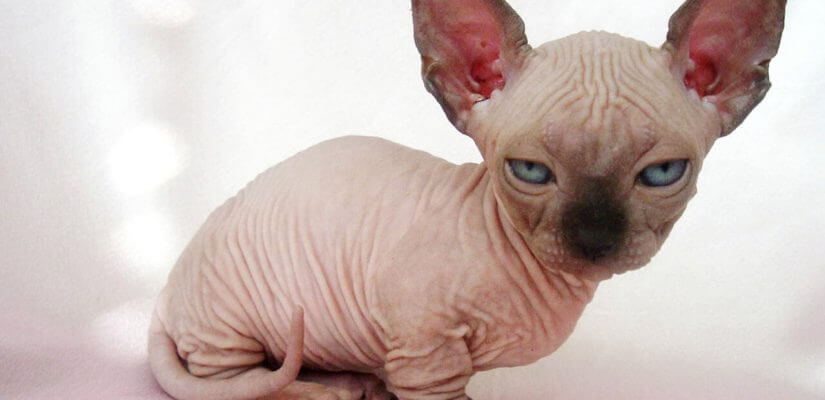
The Minskin is another hairless breed with short legs, a cross between the Munchkin and Sphynx. They are small, affectionate cats that enjoy human interaction.
- Physical Traits: Short legs, hairless or sparsely furred skin, compact build.
- Personality: Gentle, sociable, and playful.
- Care Needs: Bathing and moisturizing are necessary, as well as protecting them from the sun and cold.
- Price Range: $1,500 – $2,500.
10. Canadian Hairless Cat

Also known as the Sphynx’s Canadian variant, the Canadian Hairless has a similar appearance but is technically classified separately in some regions.
- Physical Traits: Wrinkled skin, large ears, and eyes; muscular body.
- Personality: Friendly, energetic, and loves attention.
- Care Needs: Regular bathing, skin care, and temperature control.
- Price Range: $1,500 – $3,000.
Care Guide for Hairless Cats
Essential Grooming
Hairless cats produce more oils than their furred counterparts, which means they require regular baths to prevent their skin from becoming oily or developing acne. Gentle, hypoallergenic cat shampoo works best. Additionally, since hairless cats lack the protection of fur, they can get sunburned easily, so using pet-safe sunscreen and providing shaded areas indoors is essential. Cozy clothing during colder months helps keep them warm, as they are sensitive to temperature changes.
Skin Care
Because hairless cats are prone to skin irritations, moisturizing can help keep their skin from drying out. Regular ear cleaning is also important, as the lack of fur can lead to wax buildup. Dental care is equally vital to prevent oral issues.
Frequently Asked Questions About Hairless Cats
Are hairless cats hypoallergenic?
Hairless cats are not entirely hypoallergenic. They produce the same proteins as other cats, so individuals with cat allergies may still react.
Do hairless cats need special diets?
While they don’t need a specific diet, high-quality food can help maintain their skin health and general well-being.
What’s the average cost of a hairless cat?
Prices vary by breed, ranging from $1,200 to $3,500 depending on rarity, breeder, and location.
Are hairless cats friendly?
Yes, many hairless breeds are known for their friendly, sociable nature. They often form strong bonds with their families and enjoy attention.
How much does a hairless cat cost?
The price of a hairless cat varies by breed, quality, and breeder reputation. Sphynx cats, for instance, typically cost between $1,500 and $3,000 due to their rarity and demand, while rarer breeds like the Ukrainian Levkoy or Elf may cost even more. Adoption costs for hairless cats tend to be lower but can still range from $300 to $500, depending on the organization and availability.
Are hairless cats good pets?
Yes, hairless cats are known for their affectionate and social nature, making them excellent pets for those seeking a friendly, interactive feline. Breeds like the Sphynx and Donskoy are known to be very people-oriented, often following their owners around and enjoying snuggles. They are good with families, kids, and even other pets, but they do require a bit more attention and care due to their unique skin and temperature needs.
Do Sphynx cats smell?
While Sphynx cats do not inherently “smell,” their lack of fur means that natural oils build up on their skin more noticeably than in furry cats. This can create a slight odor if they are not bathed regularly. Weekly bathing or gentle wiping is often recommended to keep their skin clean and fresh. Proper diet and skincare can also help minimize any scent.
Do hairless cats have health problems?
Hairless cats are generally healthy but are prone to a few specific health issues. Without fur for insulation, they are more sensitive to temperature changes and are at risk of skin conditions, including sunburn, rashes, and fungal infections. Heart conditions, such as hypertrophic cardiomyopathy, are common in Sphynx cats, so regular veterinary check-ups are essential.
Do hairless cats enjoy water?
Many hairless cats are relatively tolerant of water, as they are often bathed regularly from a young age. Breeds like the Sphynx can even come to enjoy the warm water baths due to the soothing effect on their skin. However, like all cats, individual personalities vary, so some may take to water more enthusiastically than others.
How long do hairless cats live?
With proper care, hairless cats can live a long and healthy life. Sphynx cats, for example, typically live between 12-15 years, and some can live even longer with excellent care. Regular veterinary visits, a balanced diet, and attentive skincare all contribute to their longevity.
Why are Sphynx cats so expensive?
The Sphynx’s high price is due to its rarity, breeding costs, and specific care needs. Responsible breeders invest significant time and resources to ensure the health and quality of these cats, and the limited number of reputable breeders further drives up the cost. Additionally, maintaining a Sphynx’s health can require specialized diets and regular vet care, contributing to the overall investment.
What do Sphynx cats eat?
Sphynx cats benefit from a high-quality diet rich in protein to support their active metabolism. Many owners choose premium dry or wet food, and some opt for a raw diet under veterinary supervision. Their active metabolism and body temperature regulation needs mean they may eat more frequently than other cats, so maintaining a balanced, nutrient-rich diet is crucial.
Which cat breed lives the shortest?
Generally, mixed-breed cats or some large breeds like the Maine Coon may have shorter lifespans due to their size and associated health issues. Among hairless breeds, however, lifespan is relatively consistent, with most living between 10-15 years with proper care.
Do hairless cats need clothes?
Yes, hairless cats can benefit from wearing clothes, especially in cooler environments. Without fur, they are vulnerable to the cold and can feel chilled even at moderate temperatures. Lightweight sweaters or cozy shirts can help keep them warm indoors, and specially designed pet clothing is available to fit their unique physique comfortably.
Which cat breed loves water?
The Sphynx cat is known for its tolerance, and in some cases, enjoyment of water, making it one of the most water-friendly cat breeds. The frequent need for baths helps many Sphynx cats become more comfortable with water than most other cats.
Can hairless cats go outside?
Hairless cats can go outside, but it requires caution. Due to their vulnerability to sunburn and temperature fluctuations, they should be supervised, wear pet-safe sunscreen, and avoid prolonged sun exposure. Many owners prefer to keep hairless cats as indoor-only pets or provide a sheltered outdoor space where they are safe from environmental risks.
Conclusion
Hairless cats are an extraordinary group of felines with distinctive care needs. From the popular Sphynx to the unique Lykoi, each breed offers something special in terms of personality, appearance, and companionship. With the right care, grooming, and a cozy, safe environment, hairless cats can thrive as cherished pets, offering their families endless affection and charm.
- Golden Retriever Pros and Cons: What Every Pet Parent Should Know - 15 September 2025
- Cane Corso Dog Breed: Health, Care, and Lifespan - 14 September 2025
- Catahoula Leopard Dogs: Description, Temperament, Lifespan, & Facts - 21 July 2025


